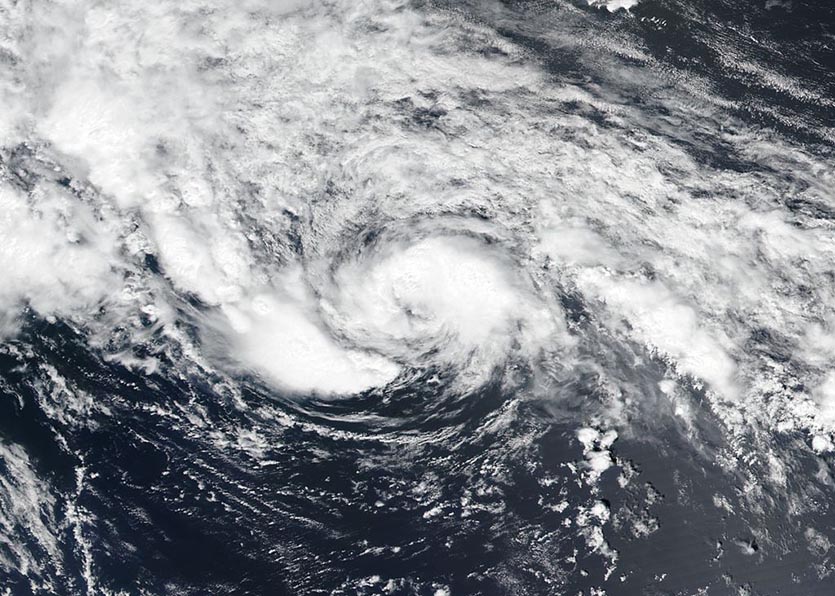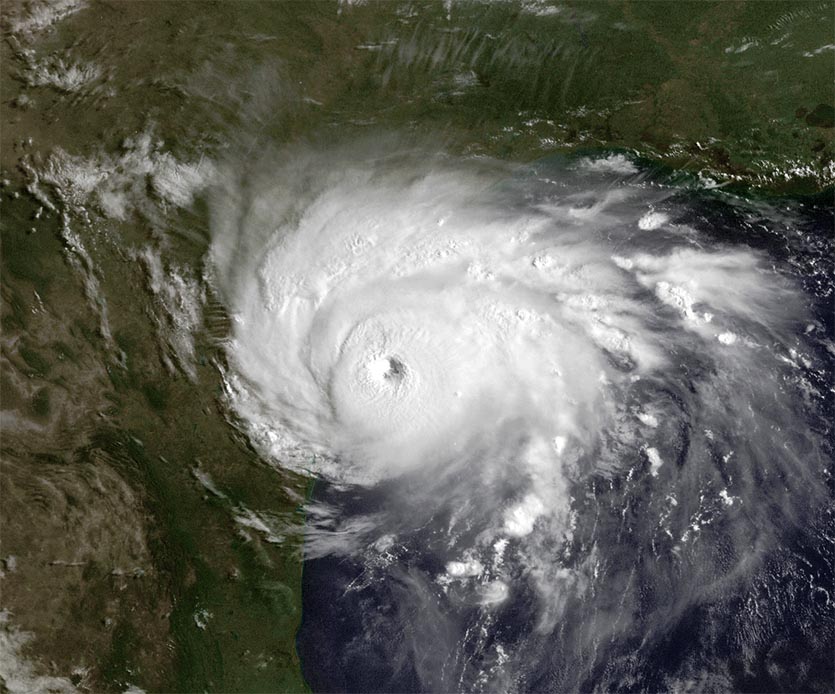| Above: Hurricane Emily south of Jamaica at 11:45 am EDT July 16, 2005. At the time, Emily was a top-end Category 4 storm with 155 mph winds, and it would achieve Category 5 strength that evening. Emily is the only name on the active list of names for the Atlantic that for a hurricane that achieved Category 5 strength in the past, yet did not get its name retired. Image credit: NASA. |
The next name on the list of Atlantic hurricanes is Emily, a name that has been used six times in the past for an Atlantic tropical cyclone. Two of those Emily incarnations--in 1987 and in 2005--were so fierce that I thought for sure that the storm would get its name retired. But no, the name Emily lived on, awaiting a truly ferocious and damaging appearance to force its retirement. Emily’s situation got me thinking--what Atlantic named storms came closest to achieving the notoriety needed to get their names retired, but fell short? The list is an interesting and surprising one.
Hurricane naming and retirement
Hurricanes began getting names in 1950, when the U.S. Weather Bureau began using the phonetic alphabet (Able-Baker-Charlie). In 1953, women’s names were substituted, and in 1979, the World Meteorological Organization (WMO) and the U.S. National Weather Service switched to a series of six lists of names that also included men's names. Each of those lists is recycled every six years, unless a hurricane gets its name retired. Any nation impacted by a severe hurricane or tropical storm can lobby the WMO to have the name of that storm retired. The retired list includes two tropical storms--Allison of 2001, which caused $12.4 billion (2017 dollars) in flood damage to Texas, and Tropical Storm Erika of 2015, which did half a billion in damage to Dominica and killed 30 people there.
 |
| Figure 1. Tropical Storm Gordon at 7 am EST November 12, 1994. At the time, Gordon was a minimal tropical storm with 40 mph winds, but was drenching Haiti with torrential rains. Image credit: NOAA/HURSAT. |
The active name most deserving of retirement: Gordon
The name Gordon has been used four times--in 1994, 2000, 2006, and 2012--and will be reused in 2018. However, the first incarnation of Gordon in November 1994 really should have resulted in the name Gordon being permanently retired. On November 13, Gordon hit Jamaica and Eastern Cuba as a minimal tropical storm, where its heavy rains led to flooding that killed six and did over $100 million in damage. Gordon then turned west-northwest to affect Florida, where $400 million in damage and eight deaths resulted. It eventually became a Category 1 hurricane, a few hundred miles east of Florida. But the main tragedy of the storm occurred in Haiti, where the broad circulation of Gordon produced a persistent southerly flow that resulted in torrential rains over mountainous regions. Rainfall amounts as high as thirteen inches in twelve hours fell, resulting in devastating flooding and mudslides that officially killed 1,122 Haitians. The total death toll in all nations affected by Gordon was 1,145, making it the seventh deadliest Atlantic hurricane in the 1950 – 2016 period. Haiti, which even in the best of years is focused simply on surviving, did not care to submit a request to the WMO to have the name Gordon retired--and neither did the other nations affected by the storm.
According to the National Hurricane Center list of deadliest Atlantic tropical cyclones, there are only two other names scheduled to be reused which belonged to previous storms that killed over 100 people: Beryl and Bret. Tropical Storm Beryl of 1982 killed 115 people in the Cabo Verde Islands, and Tropical Storm Bret of 1993 killed 184 people in Venezuela, Nicaragua and Colombia. Beryl will appear again in 2018, and Bret is scheduled for 2023.
 |
| Figure 2. The name Emily has been used six times since 1981, but none of these appearances was judged significant enough for the name to get retired. The 1987 version of Emily hit Hispaniola as a high-end Category 2 hurricane, and also hit Bermuda at Category 1 strength. Total damage was $80 million, with two fatalities. The center of Hurricane Emily of 1993 passed just east of Cape Hatteras, North Carolina, with the calm of the eye and the western eyewall moving over the Outer Banks. Total damage was $30 million, with three fatalities. Hurricane Emily of 2005 made landfall in Grenada as a Category 1 storm, then did a double landfall in Mexico--first at Category 4 strength in Cozumel, then at Category 3 strength south of Brownsville, Texas. Total damage was $1.01 billion, with six direct deaths. image credits: NOAA and NASA, except for the picture from inside the eye of 1987's Emily, which I took. |
The only Category 5 hurricane not to get its name retired: Emily of 2005
There have been 23 Category 5 hurricanes in the Atlantic since we began naming hurricanes in 1950. Only two of those mighty storms did not get their names retired--2005’s Hurricane Emily, and 1971's Hurricane Edith. Edith's name has been dropped from the active list of storms, though, leaving Emily as the only former Category 5 storm to still have its name in the active list of storms. Emily achieved Category 5 status for six hours on July 17, 2005, as it passed to the southwest of Jamaica. The hurricane weakened to a Category 4 storm with 130 mph winds before making landfall on the Mexican coast near Cozumel Island, bringing a storm surge of up to 15 feet. Emily went on to cross the Gulf of Mexico and slam ashore on the Mexican coast south of Brownsville, Texas, as a Category 3 hurricane. Emily's double strike on the country as a major hurricane did approximately $1 billion (2017 dollars) in damage. Amazingly, Mexico suffered no direct deaths from the hurricane, thanks to massive evacuations involving nearly 100,000 people, mostly tourists. (Three indirect deaths were blamed on the hurricane, including two people killed in a helicopter crash during the evacuation of offshore oil rigs.) Mexico’s preparations for Hurricane Emily of 2005 thus stand as one of the most remarkable civil defense success stories of all-time. Perhaps Mexico’s pride in this brilliant accomplishment kept them from requesting that the name Emily be retired from the list of hurricane names!
The seven billion-dollar Atlantic named storms that did not get their names retired
There have been 50 Atlantic named storms that have caused at least $1 billion in damage (unadjusted for inflation), according to damage statistics from the National Hurricane Center compiled on Wikipedia. Of these fifty storms, only seven have not had their names retired:
| Rank | Name | Year | Type of Storm | Damage | Location |
| 1 | Isaac | 2012 | Category 1 hurricane | $2.39 billion | Caribbean, Eastern U.S. |
| 2 | Alex | 2010 | Category 2 hurricane | $1.855 billion | Mexico |
| 3 | Lee | 2011 | Tropical Storm | $1.6 billion | Eastern U.S. |
| 4 | Juan | 1985 | Category 1 hurricane | $1.5 billion | U.S. Gulf Coast |
| 5 | Dolly | 2008 | Category 2 hurricane | $1.35 billion | Texas, Mexico |
| 6 | Emily | 2005 | Category 5 hurricane | $1.014 billion | Mexico, Grenada, Jamaica |
| 7 | Alberto | 1994 | Tropical Storm | $1.0 billion | Southeast U.S. |
 |
| Figure 3. Sorry, not this time, either! In its eleventh appearance in the Atlantic since 1959, Tropical Storm Arlene, located to the west of the Azores on April 20, 2017, fails to impress. See you in 2023, Arlene! Image credit: NASA. |
The most chances to get retired: Arlene
Only five Atlantic storm names have been recycled as many as eight times. The storm with the most opportunities to get its name retired has been Arlene, which has appeared eleven times: 1959, 1963, 1967, 1971, 1981, 1987, 1993, 1999, 2005, 2011, and again in 2017. The other members of the eight-plus appearances club are Cindy (9), Florence (9), Dolly (8) and Frances (8). Frances finally got its name retired after its eighth appearance in 2004, when it ravaged central Florida as a Category 2 storm. The other storms will come again. Thanks go to wunderground member Mark Cole for providing the statistics on these five frequent visitors (and on the damaging storms listed above):
Arlene (11): 1959 - TS; 1963 - H2; 1967 - H1; 1971 - TS; 1981 - TS; 1987 - H1; 1993 - TS; 1999 - TS; 2005 - TS; 2011 – TS; 2017 - TS
Cindy (9): 1959 - H1; 1963 - H1; 1981 - TS; 1987 - TS; 1993 - TS; 1999 - H4; 2005 - H1; 2011 – TS; 2017 - TS
Florence (9): 1953 - H3; 1954 – TS (x); 1960 - TS; 1964 - TS; 1988 - H1; 1994 - H2; 2000 - H1; 2006 - H1; 2012 - TS
Frances (8): 1961 - H3; 1968 - TS; 1976 - H3; 1980 - H3; 1986 - H1; 1992 - H1; 1998 - TS; 2004 - H4 (RETIRED)
Dolly (8): 1953 – H1 (x); 1954 – H1 (x); 1968 - H1; 1974 - TS; 1996 - H1; 2002 - TS; 2008 - H2; 2014 - TS
Key to abbreviations: TS - Tropical Storm; H1 - Hurricane, Cat. 1; H2 - Hurricane, Cat 2; H3 - Major Hurricane, Cat 3; H4 - Major Hurricane, Cat 4; H5 - Major Hurricane, Cat 5. (x) = Storms that have this symbol are ones where the Hurricane Database Re-Analysis Project (HURDAT) did a reanalysis and made a correction to the original intensity of that storm; the intensities shown here are the corrected ones.
 |
| Figure 4. Hurricane Bret shortly after peak intensity on August 22, 1999. Image credit: NOAA. |
The only major U.S. landfalling hurricane not to get its name retired: Bret of 1999
Since people’s names began being used for Atlantic hurricanes in 1953, there have been 28 major (Category 3 and stronger) hurricanes to make landfall in the United States. All but one of these has had its name retired. The exception? None other than Hurricane Bret of 1999, which rapidly intensified to Category 4 strength with 145 mph winds in the Gulf of Mexico on August 22, 1999. Bret weakened to a Category 3 storm with 115 mph winds before making landfall at 8 pm EDT August 22, 1999, along Texas’s Padre Island, midway between Brownsville and Corpus Christi. Due to Bret’s small size and the sparsely-populated region of the coast it hit, damage was limited to $60 million, and just one life was lost.



